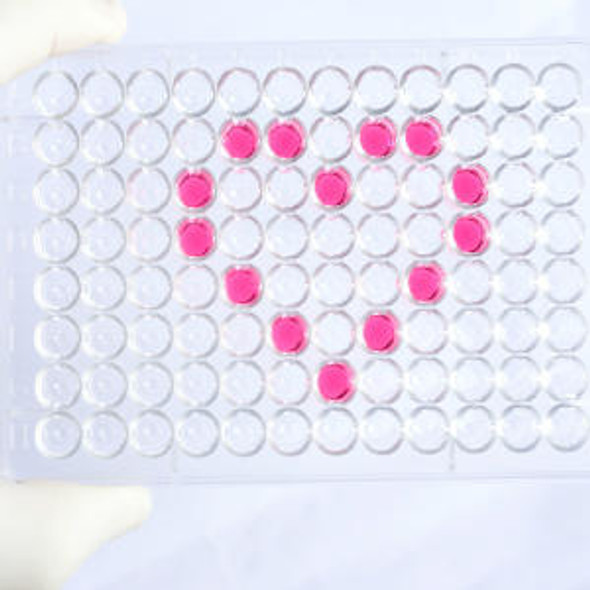Human Cell Biology ELISA Kits 1
Human RELN (Reelin) ELISA kit (HUES03210)
- SKU:
- HUES03210
- Product Type:
- ELISA Kit
- Size:
- 96 Assays
- Uniprot:
- P78509
- Sensitivity:
- 0.09ng/mL
- Range:
- 0.16-10ng/mL
- ELISA Type:
- Sandwich
- Synonyms:
- RELN , LIS2, PRO1598, RL
- Reactivity:
- Human
- Sample Type:
- Serum, plasma and other biological fluids
- Research Area:
- Cell Biology
Description
| Assay type: | Sandwich |
| Format: | 96T |
| Assay time: | 4.5h |
| Reactivity: | Human |
| Detection Method: | Colormetric |
| Detection Range: | 0.16-10 ng/mL |
| Sensitivity: | 0.10 ng/mL |
| Sample Volume Required Per Well: | 100µL |
| Sample Type: | Serum, plasma and other biological fluids |
| Specificity: | This kit recognizes Human RELN in samples. No significant cross-reactivity or interference between Human RELN and analogues was observed. |
This ELISA kit uses Sandwich-ELISA as the method. The micro ELISA plate provided in this kit has been pre-coated with an antibody specific to Human RELN. Standards or samples are added to the appropriate micro ELISA plate wells and combined with the specific antibody. Then a biotinylated detection antibody specific for Human RELN and Avidin-Horseradish Peroxidase (HRP) conjugate are added to each micro plate well successively and incubated. Free components are washed away. The substrate solution is added to each well. Only those wells that contain Human RELN, biotinylated detection antibody and Avidin-HRP conjugate will appear blue in color. The enzyme-substrate reaction is terminated by adding Stop Solution and the color turns yellow. The optical density (OD) is measured spectrophotometrically at a wavelength of 450 nm ± 2 nm. The OD value is proportional to the concentration of Human RELN. The concentration of Human RELN in samples can be calculated by comparing the OD of the samples to the standard curve.
| UniProt Protein Function: | reelin: Extracellular matrix serine protease that plays a role in layering of neurons in the cerebral cortex and cerebellum. Regulates microtubule function in neurons and neuronal migration. Affects migration of sympathetic preganglionic neurons in the spinal cord, where it seems to act as a barrier to neuronal migration. Enzymatic activity is important for the modulation of cell adhesion. Binding to the extracellular domains of lipoprotein receptors VLDLR and LRP8/APOER2 induces tyrosine phosphorylation of DAB1 and modulation of TAU phosphorylation. Defects in RELN are the cause of lissencephaly type 2 (LIS2); also known as lissencephaly with cerebellar hypoplasia or Norman-Roberts syndrome. LIS2 is a classic type lissencephaly associated with abnormalities of the cerebellum, hippocampus and brainstem. Individuals with LIS2 are severely ataxic, mentally retarded and suffer from epilepsy. Belongs to the reelin family. 3 isoforms of the human protein are produced by alternative splicing. |
| UniProt Protein Details: | Protein type:Cell development/differentiation; Secreted; Cell adhesion; EC 3. 4. 21. -; Protease; Secreted, signal peptide; Motility/polarity/chemotaxis Chromosomal Location of Human Ortholog: 7q22 Cellular Component: extracellular space; proteinaceous extracellular matrix; cytoplasm; dendrite Molecular Function:serine-type peptidase activity; metal ion binding; protein serine/threonine/tyrosine kinase activity Biological Process: cellular morphogenesis during differentiation; axon guidance; central nervous system development; peptidyl-tyrosine phosphorylation; spinal cord patterning; neuron migration; response to pain; proteolysis; positive regulation of synaptic transmission, glutamatergic; glial cell differentiation; dendrite development; cell adhesion; layer formation in the cerebral cortex; positive regulation of TOR signaling pathway; associative learning; regulation of behavior; regulation of synaptic transmission; cerebral cortex tangential migration; hippocampus development; activation of CREB transcription factor; ventral spinal cord development; positive regulation of phosphoinositide 3-kinase cascade; positive regulation of small GTPase mediated signal transduction; positive regulation of peptidyl-tyrosine phosphorylation; long-term memory; positive regulation of protein kinase activity; brain development Disease: Epilepsy, Familial Temporal Lobe, 7; Lissencephaly 2; Epilepsy, Familial Temporal Lobe, 1 |
| NCBI Summary: | This gene encodes a large secreted extracellular matrix protein thought to control cell-cell interactions critical for cell positioning and neuronal migration during brain development. This protein may be involved in schizophrenia, autism, bipolar disorder, major depression and in migration defects associated with temporal lobe epilepsy. Mutations of this gene are associated with autosomal recessive lissencephaly with cerebellar hypoplasia. Two transcript variants encoding distinct isoforms have been identified for this gene. Other transcript variants have been described but their full length nature has not been determined. [provided by RefSeq, Jul 2008] |
| UniProt Code: | P78509 |
| NCBI GenInfo Identifier: | 1743885 |
| NCBI Gene ID: | 5649 |
| NCBI Accession: | AAC51105. 1 |
| UniProt Secondary Accession: | P78509,Q86UJ0, Q86UJ8, Q8NDV0, Q9UDQ2, A4D0P9, A4D0Q0 |
| UniProt Related Accession: | P78509 |
| Molecular Weight: | 384,093 Da |
| NCBI Full Name: | reelin |
| NCBI Synonym Full Names: | reelin |
| NCBI Official Symbol: | RELN |
| NCBI Official Synonym Symbols: | RL; ETL7; LIS2; PRO1598 |
| NCBI Protein Information: | reelin |
| UniProt Protein Name: | Reelin |
| UniProt Gene Name: | RELN |
| UniProt Entry Name: | RELN_HUMAN |
As the OD values of the standard curve may vary according to the conditions of the actual assay performance (e. g. operator, pipetting technique, washing technique or temperature effects), the operator should establish a standard curve for each test. Typical standard curve and data is provided below for reference only.
| Concentration (ng/mL) | O.D | Average | Corrected |
| 10 | 2.523 2.579 | 2.551 | 2.467 |
| 5 | 1.648 1.692 | 1.67 | 1.586 |
| 2.5 | 1.04 1.01 | 1.025 | 0.941 |
| 1.25 | 0.531 0.549 | 0.54 | 0.456 |
| 0.63 | 0.297 0.293 | 0.295 | 0.211 |
| 0.32 | 0.204 0.182 | 0.193 | 0.109 |
| 0.16 | 0.132 0.146 | 0.139 | 0.055 |
| 0 | 0.075 0.093 | 0.084 | -- |
Precision
Intra-assay Precision (Precision within an assay): 3 samples with low, mid range and high level Human RELN were tested 20 times on one plate, respectively.
Inter-assay Precision (Precision between assays): 3 samples with low, mid range and high level Human RELN were tested on 3 different plates, 20 replicates in each plate.
| Intra-assay Precision | Inter-assay Precision | |||||
| Sample | 1 | 2 | 3 | 1 | 2 | 3 |
| n | 20 | 20 | 20 | 20 | 20 | 20 |
| Mean (ng/mL) | 0.49 | 1.46 | 3.87 | 0.50 | 1.59 | 3.82 |
| Standard deviation | 0.03 | 0.08 | 0.18 | 0.03 | 0.08 | 0.14 |
| C V (%) | 6.12 | 5.48 | 4.65 | 6.00 | 5.03 | 3.66 |
Recovery
The recovery of Human RELN spiked at three different levels in samples throughout the range of the assay was evaluated in various matrices.
| Sample Type | Range (%) | Average Recovery (%) |
| Serum (n=5) | 90-101 | 96 |
| EDTA plasma (n=5) | 90-103 | 97 |
| Cell culture media (n=5) | 92-104 | 98 |
Linearity
Samples were spiked with high concentrations of Human RELN and diluted with Reference Standard & Sample Diluent to produce samples with values within the range of the assay.
| Serum (n=5) | EDTA plasma (n=5) | Cell culture media (n=5) | ||
| 1:2 | Range (%) | 93-110 | 97-113 | 92-106 |
| Average (%) | 100 | 104 | 99 | |
| 1:4 | Range (%) | 92-107 | 84-98 | 86-98 |
| Average (%) | 99 | 91 | 92 | |
| 1:8 | Range (%) | 89-99 | 81-93 | 85-99 |
| Average (%) | 94 | 87 | 90 | |
| 1:16 | Range (%) | 86-101 | 86-98 | 81-93 |
| Average (%) | 93 | 92 | 88 |
An unopened kit can be stored at 4°C for 1 month. If the kit is not used within 1 month, store the items separately according to the following conditions once the kit is received.
| Item | Specifications | Storage |
| Micro ELISA Plate(Dismountable) | 8 wells ×12 strips | -20°C, 6 months |
| Reference Standard | 2 vials | |
| Concentrated Biotinylated Detection Ab (100×) | 1 vial, 120 µL | |
| Concentrated HRP Conjugate (100×) | 1 vial, 120 µL | -20°C(shading light), 6 months |
| Reference Standard & Sample Diluent | 1 vial, 20 mL | 4°C, 6 months |
| Biotinylated Detection Ab Diluent | 1 vial, 14 mL | |
| HRP Conjugate Diluent | 1 vial, 14 mL | |
| Concentrated Wash Buffer (25×) | 1 vial, 30 mL | |
| Substrate Reagent | 1 vial, 10 mL | 4°C(shading light) |
| Stop Solution | 1 vial, 10 mL | 4°C |
| Plate Sealer | 5 pieces | |
| Product Description | 1 copy | |
| Certificate of Analysis | 1 copy |
- Set standard, test sample and control (zero) wells on the pre-coated plate and record theirpositions. It is recommended to measure each standard and sample in duplicate. Note: addall solutions to the bottom of the plate wells while avoiding contact with the well walls. Ensuresolutions do not foam when adding to the wells.
- Aliquot 100µl of standard solutions into the standard wells.
- Add 100µl of Sample / Standard dilution buffer into the control (zero) well.
- Add 100µl of properly diluted sample (serum, plasma, tissue homogenates and otherbiological fluids) into test sample wells.
- Cover the plate with the sealer provided in the kit and incubate for 90 min at 37°C.
- Aspirate the liquid from each well, do not wash. Immediately add 100µL of BiotinylatedDetection Ab working solution to each well. Cover the plate with a plate seal and gently mix. Incubate for 1 hour at 37°C.
- Aspirate or decant the solution from the plate and add 350µL of wash buffer to each welland incubate for 1-2 minutes at room temperature. Aspirate the solution from each well andclap the plate on absorbent filter paper to dry. Repeat this process 3 times. Note: a microplatewasher can be used in this step and other wash steps.
- Add 100µL of HRP Conjugate working solution to each well. Cover with a plate seal andincubate for 30 min at 37°C.
- Aspirate or decant the solution from each well. Repeat the wash process for five times asconducted in step 7.
- Add 90µL of Substrate Reagent to each well. Cover with a new plate seal and incubate forapproximately 15 min at 37°C. Protect the plate from light. Note: the reaction time can beshortened or extended according to the actual color change, but not by more than 30min.
- Add 50 µL of Stop Solution to each well. Note: Adding the stop solution should be done inthe same order as the substrate solution.
- Determine the optical density (OD value) of each well immediately with a microplate readerset at 450 nm.






